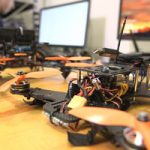Biomanufacturing innovation
Sandia scientists joined other DOE national laboratories to showcase their bioscience research and capabilities before investors, industry representatives and university partners at the Innovation XLab: Biomanufacturing Summit at the California Memorial Stadium in Berkeley, Jan. 28-29.
Secretary of Energy Achievement Awards
Sandians were members of several teams honored in November by then Energy Secretary Rick Perry in a ceremony at DOE headquarters. The teams received Secretary of Energy Achievement Awards, which recognize significant achievements by DOE employees and contractors.
Four Sandia scientists elected AIAA associate fellows
Sandia scientists Jacqueline Chen, Tucker Lavin, Humberto Silva III and Justin Smith have been elected associate fellows of the American Institute of Aeronautics and Astronautics. To be selected as an associate fellow, an AIAA senior member must be in good standing, with at least 12 years’ professional experience, and be recommended by a minimum of three other associate fellows.
Internships fuel research for Puerto Rico engineering students
The NNSA-sponsored Consortium for Integrating Energy Systems in Engineering and Science Education internship program connects engineering students from five Hispanic-serving institutions, including UPRM, with research at Sandia and the National Energy Technology Laboratory in Morgantown, West Virginia.
R&D 100
The venerable R&D 100 contest, slightly more than 50 years old, has a new owner, and the competition continues. Competing in an international pool of universities, corporations and government labs, Sandia inventions captured four R&D 100 Awards this year, as well as two environmental and one business award.
Engineering success through predicting failure
Around the world, materials scientists and engineers are trying different ways to predict fractures in ductile metals, but it’s not clear which approach is most accurate. To compare the different methods, Sandia researchers have presented three voluntary challenges to their colleagues: Given the same basic information about the shape, composition and loading of a metal part, could they predict how it would eventually fracture?
Lowering the bar for hydrogen-powered technology
The Hydrogen Materials Advanced Research Consortium, or HyMARC, a multilab collaboration co-led by Sandia, is developing two types of hydrogen storage materials to meet challenging energy density targets set forth by DOE. The newly expanded collaboration is using the most promising strategies to optimize the materials for future use in vehicles.
Armoring satellites to survive, operate through attacks
Researchers at Sandia launched a seven-year mission campaign this month to develop the science, technology and architecture needed for autonomous satellite protection systems. The campaign, called STARCS, will fund dozens of Laboratory Directed Research and Development projects.
Autonomy New Mexico interns build drones to test hypersonic tech
Sandia is developing autonomy and artificial intelligence for flight systems soaring at more than 3,800 mph. The technologies to get there will initially be tested on drones that shuffle around at about 5 mph.
Steve Younger signs annual stockpile assessment letter
Laboratories Director Steve Younger signed Sandia’s annual nuclear weapons stockpile assessment letter in late September. Completion of this annual assessment letter is required by law, and is one of the principal responsibilities of the Labs director.









